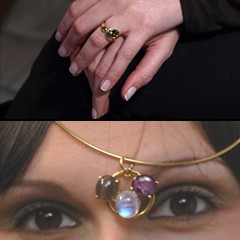
Mother Nature took little spheres of semitransparent hydrated silica. The spheres are very small, just visible at forty thousand magnifications, and between the lattice of spheres, water and gas have been compressed, so that it has a compact mass. If we’re lucky, light will play in this sort of solid jelly in a bizarre way: trying to cross the silicon spheres, it will be refracted, diffracted, divided in the colors of the rainbow, and will give rise to bolts of lightning, sparks, polychrome firebolts that change and vibrate and sparkle and amaze with new chromatic emotions.

An archipelago of fixed islands, which are patches of outcropping matrix is surrounded by a glittering sea of a thousand colors in this stunning multi-color opal.
Many lapidaries house opal stones in water-filled jars. Opal is a hydrated silicate; water is of the upmost importance in its structure. During processing, some composition water can be lost, due to vibration or due to overheating from polishing. For this reason they are left in water for a few days, and it is good practice, even afterwards, to soak them in water for a while, every now and then. In the deserts of Mexico, also the magical cactus “Peyotle”, grows underground to guard the precious water reserves for months and years, and gives only a few centimeters of its head to the arid area surrounding it; vegetation and fauna are specialized to treasure every drop of dew, every hint of moisture,
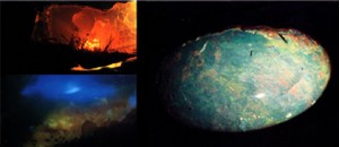
and the desire for color is expressed in the monotony of the brown parched earth, on rare berries of the brightest color, on rare rocks that open their colored veins in the direction of the light, on the darting of eyes and forked tongues of animals that you do not distinguish from the absolute brown that overwhelms all and dusts all, and you wonder whether any stone could have possibly made a supply of water,
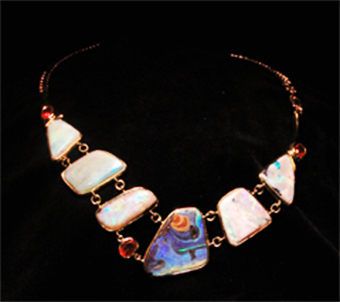
light and color, and with this state of mind you reach places where you dig for opals. As with all precious things, you have to search, see, study many before you actually do find a truly emotional piece. And it is when you have finally found the right piece, that you find yourself hurled into the chromatic kaleidoscope of other experiences, other dreams, other stories, other horizons, and you see this crystallized water that has absorbed and fragmented a rainbow and mixed it into millions of butterfly wings, and you realize that the ten thousand colors that you see are only a small part of the countless colors that your eyes are not allowed to see, but something inside you still managed to perceive.
With slow movements, move this little pebble between your fingers, the colors change, colors always the same and always different, upto intruding in electric purple sunsets of impossible landscapes, in the green spark of unlikely pomegranates crumbling; and colors are a gateway, a small opening to have access to unknown dimensions which you can sense only at times, maybe for a instant, for the time of an impression, for a blink of an eye and for a heartbeat; and this seed of light and of color that is in your hand, this water-crystal, this water-based mineral, water-crystal, which embodies the secret of the rainbow, the bridge between you and your dreams, and this semitransparent pebble is home for colors and lights and flashes and blazes and sparks and the lymph of other waters and other geological eras, other forests and rainbows, other fires and other horizons.
In Mexico and in Australia, in the most monotonous deserts and in the fiercest drought, are where opals, water-based stones, are found; and every stone embodies all the colors without these having been mixed, so each color retains its individuality, brightness, hue, blitheness and desire to express itself, and every stone has a history of sunsets and sunrises and firestorms to tell, and each gem will tell you different things personally, and will give unique emotions, and will accompany you on a non-programmable journey, but which is still color-guided, light, imagination, color research and the light within, the desire to express itself with joy and colors and lights, because if a stone can manage to do so so well, surely the same may apply to us, we have perhaps become a little lazy due to all practical possibilities that our specializations offer us, and we have to know how to improve certain skills in order to obtain something that is qualitatively compelling, and we have to learn from the cactus that knows how to enclose water in the desert, learn from the sapphire so hard and unchangeable that knows how to form in a highly mobile world imbued with life as the tropical forest, learn from the opal that knows how to encapsulate colors of all coral reefs, of all tropical flowers, of all butterfly wings in the world in the most arid and desert areas, and participating to all this knowledge, these little acknowledgements, enjoy the sense of balance that makes it possible that sapphire and opal, mosquito and leech and brown bear, emerald quarries and tropical rivers and big cities, rainbows and deserts and cactus and tea plantations, drought and hurricane, the grayness of the desert and the paroxysm of colors of the forest, man and his dreams and the dreams of the world, small gems that sparkle on our fingers and small stars that shine in the sky; that all this coexist on the same earth.
Some magic texts explain that opal, as well as being capable of emitting all colors, is also able to absorb them all, and thus make invisible those who wear them. For this reason, opal was considered the best talisman for thieves, politicians and journalists! Perhaps it is also for these strange ideas that in Italy opal is considered a bad luck stone. This is good, since it means that strong emotional values are given to stones. However, until proven otherwise, we will continue to argue that opal is such a beautiful gem that it can only arouse positive emotions, and therefore bring happiness to its owner.
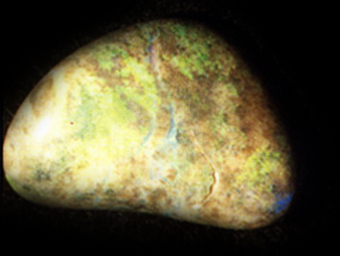
Australian boulder opal. The presence of a lot of matrix does not affect the charm of these natural kaleidoscopes.
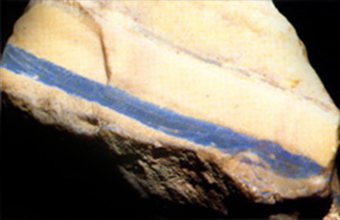
The vein of the noble opal can be thin; this leads to incredible difficulties in assessing its raw value, and for the lapidary, it takes much intuition not to waste material.
Specifications
Opal can be located in the silicates group. Some authors place it in the quartz group; which, in our opinion is improper, because opal is not crystalline, it is not even microcrystalline, but it is unstructured, it is a “gel” of silicon microgranules, generally formed as a result of a perminealization processes (along with replacement and recrystallization -successive stages of silification).
Composition: SiO2 + n (H2O). Water occupies the interstices between the silicon spheres (together forming the ‘sol’), and is present in variable amounts; in samples of gemological interest, it is approximately 10%.
Crystallization: Missing. Hardness: 5.5 – 6.5
Specific Weight: 1.9 – 2.3
Refractive index: 1:23 to 1:46
Color: The “bottom” part of the stone can be: Colourless (water opal), Milky (milky opal, common opal), Very dark (black opal), Intense Orange (Fire Opal). There are dozens of other fancy names, linked to local traditions. There can be many different names depending on the type of the color effects shown by the gem, such as: noble opal, harlequin, butterfly, black, and many others. Unfortunately it is not possible to establish, with certainty, where one type ends and where another type begins. The most prized opal will certainly have a more striking play of colors; but even those opals with little or no light effects can be pleasant. For eg., the fire opal, which is a wonder in its flaming variety, and i also appreciated in its most common variety without light effects. Imitations, doublets, synthetic. Given the great decorative power of this gem, there exist a variety of imitations. These range from glass paste to doublets, to triplets, to truly synthetic ones. Doublets and triplets (they can be distinguished very easily), are layers of different material glued together with a sheet of opal (natural or synthetic) in between. Since when with the use of the electron microscope it has been possible to see opal’s grain structure, it has also been possible to reproduce it in the lab: these syntheses can be very misleading.
Matrix: Often there are traces of the mother rock, especially at the bottom of the stone or at the sides. The specimens with a thin layer of opal on a thicker layer of the mother rock, are called “Boulder”.
Cut: cabochon generally, often with bizarre shapes that follow the shape of the original nodule. The bottom of the cabochon can be smooth or shiny, depending on the imagination of those who wrought it. In some cases the opalization process has been accompanied by the process of fossilization; so you may find opalized shells, crabs, bones and fossil wood of great beauty. In these circumstances, both the ‘opal‘ and the ‘fossil’ features are highligted as much as possible.
Origin: In addition to Australia and Mexico; Madagascar, Brazil, Ethiopia, Oregon and other areas. Often, opal has a distant fossil source (shells, wood, bones). Each arrangement provides specimens with characteristics linked to the area of extraction. Often these are so different characteristics, that we may be inclined to think they belong to different species of gems.










